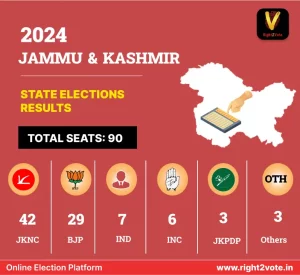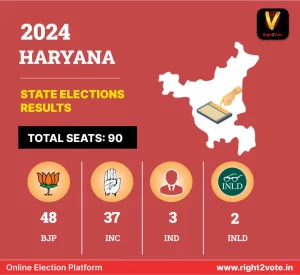Jammu & Kashmir and Haryana Elections 2024 – Landmark Election Results

The political climate in Haryana and Jammu & Kashmir is poised for major shifts in 2024. In Jammu & Kashmir, as this election is the first since the historic abrogation of Article 370 in 2019, this represents a significant turning point for the region in Jammu & Kashmir. Meanwhile, Haryana turned into a battlefield in a hotly waged conflict. Important topics that influenced the political conversation included anti-incumbency, farmers’ MSP and wrestlers’ protests. Still unexpectedly, BJP was able to win the election for the third time in a row.
Jammu & Kashmir: A New Beginning
We all looked forward to the Jammu & Kashmir elections of 2024. After Article 370 which had previously given the state extraordinary autonomy was revoked, this was the first election that followed. With an impressive 69.67% of voters, the people of Jammu & Kashmir appeared committed to determining their own destiny in this new era. Voter turnout of around 70% proved that citizens of J&K voted in favour of Democracy.

Comparison with the 2014 Elections
In the 2014 Jammu & Kashmir elections, the JKPDP had emerged as the single largest party with 28 seats, closely followed by BJP with 25 seats, and JKNC with 15 seats. When we fast-forward to 2024, we see a big difference:
- The JKNC has made a tremendous comeback, jumping from 15 seats in 2014 to 42 seats in 2024. This could be seen as a resurgence of regional identity politics, with many voters rallying behind the party that promises to protect the region’s distinct identity.
- The BJP, which had positioned itself as a major contender, won 29 seats, slightly increasing its strength from 2014’s 25 seats. Their performance reflects their stronghold in Jammu but shows limitations in the Kashmir valley.
- JKPDP, once a dominant player, saw its influence drastically diminish, securing only 3 seats, compared to 28 in 2014. This decline can be attributed to dissatisfaction with the party’s role in previous coalition governments and a loss of confidence among its core voters.
- It can also suggest that voters of Kashmir voted intelligently and consolidated the anti-BJP vote and avoided it from being divided between JKNC, JKPDP and INC. Generally, people in the valley, who are predominantly Muslims after the exodus of Hindus in the 1990s, vote against the BJP which is seen as more of a Hindu Party. Many Kashmir voters also wanted to vote against BJP for removing Article 370. People of Kashmir were expected to vote in favor of either of the two big JK focused parties JKNC or JKPDP. Considering Congress got into alliance with JKNC, and Congress is the only big national party which is an alternative to BJP at national level, the alliance of JKNC and Congress appeared a better alternative to Kashmiri voters compared to JKPDP.
- What also worked against JKPDP and hence in favor of JKNC was JKPDP’s alliance with BJP in between 2015 and 2019. Anti-BJP voters not only wanted to punish JKPDP for alliance with BJP but also wanted to ensure that one of the two JK parties gets a clear mandate this time so that BJP, which is strong in Jammu, does not again gets a chance to form a government in alliance with one of the JK parties.
Haryana: Breaking the History
Once again, the BJP emerged victorious in Haryana, BJP has formed the government three times in a row. However, the INC put up a fierce battle and narrowed the gap, so this victory was not without difficulties. BJP was almost certain to lose due to factors like anti-incumbency, allegations of sexual harassment of wrestlers against a BJP minister, farmer agitation. However, BJP surprised everybody including the exit polls by winning this election.

Comparison with the 2019 Elections
In the 2019 Haryana state elections, the BJP had secured 40 seats, while the INC got 31 seats. Independent candidates and regional parties like the INLD played a crucial role in the government formation.
- In 2024, the BJP strengthened its hold with 48 seats, an increase of 8 seats from 2019. Their consistent performance over the last decade has allowed them to maintain their influence, and hence they managed to achieve the historical feat of a third consecutive government.
- The INC improved its tally by 6 seats, rising from 31 in 2019 to 37 in 2024, signaling a revival of the Congress under new leadership and renewed efforts to connect with the voters.
- The INLD, once a major force in Haryana politics, has been reduced to just 2 seats, reflecting the party’s continued struggle to stay relevant in a rapidly changing political landscape.
What These Elections Mean for the Future
The 2024 elections in Jammu & Kashmir and Haryana are more than numbers on a chart. They represent a shift in political tides and the struggle between national and local forces.
- In Jammu & Kashmir, the overwhelming support for the JKNC signals a desire to reclaim a sense of autonomy and cultural pride in the post-Article 370 era, while the BJP’s performance shows their continued appeal in Jammu.
- In Haryana, the BJP’s consistent governance and the INC’s resurgence have set the stage for a competitive political future. Haryana remains a battleground of alternating political dominance.
Online Voting Can Impact Results
The results we see today may not stay the same if the voter turnout increases. In Jammu & Kashmir, the voter turnout was around 69.67%, while in Haryana, it stood at 67%. But imagine if these numbers increased to 90% the very landscape of the election could shift dramatically. This increase in participation could have changed the balance of power in both regions. Enabling online voting in Kashmir would allow Kashmiri Pandits, who migrated, to exercise their right to vote. This strengthens their connection to the region and sense of belonging. It would boost voter participation, ensuring wider representation in elections and enhancing democratic engagement.
One key factor that could elevate voter turnout is the adoption of Online Election Technology. Today, the elections in these states are conducted using EVMs (Electronic Voting Machines). While EVMs are effective, they come with certain geographical limitations. Many voters, particularly those in remote or inaccessible areas, face difficulties reaching polling stations. There’s also the risk of paper ballots being torn or misplaced.
At Right2Vote, we conduct more than 3000 elections every year across various sectors, including corporate voting, housing society elections, college elections, association elections, and employee union elections. We receive numerous inquiries asking if online voting could be made available for large-scale state elections like these. Voters seek more convenient, accessible, and secure ways to cast their votes.
As a government-certified company, we take every security concern seriously, ensuring that the integrity of the election process is maintained. If online voting technology were implemented in state elections, we could likely see a surge in voter turnout. If turnout reaches 90%, it’s almost certain that the election outcomes will shift. We have the technology to make this happen, and with more voters participating, democracy would flourish.
To know more about Right2Vote’s election technology, please refer:
- Government of India certificates
- Features for eVoting
- Security and safety
- Pricing
- Our customers
- Contact Us
 Booth-Based Digital Voting via Right2Vote: The Modern Way to Vote On-Site
Booth-Based Digital Voting via Right2Vote: The Modern Way to Vote On-Site
 AI-Powered Image Verification in the Right2Vote Election Platform: How AI Is Transforming Modern Voting
AI-Powered Image Verification in the Right2Vote Election Platform: How AI Is Transforming Modern Voting
 How to Implement eVoting & eAGM in Associations: A Complete Guide for Modern Organizations
How to Implement eVoting & eAGM in Associations: A Complete Guide for Modern Organizations
 How to Implement eVoting in RWAs & Housing Societies: A Simple Guide for Committees and Residents
How to Implement eVoting in RWAs & Housing Societies: A Simple Guide for Committees and Residents
